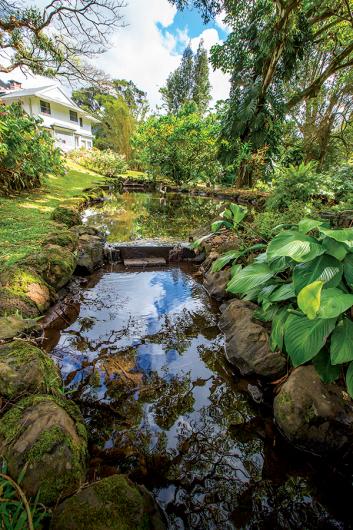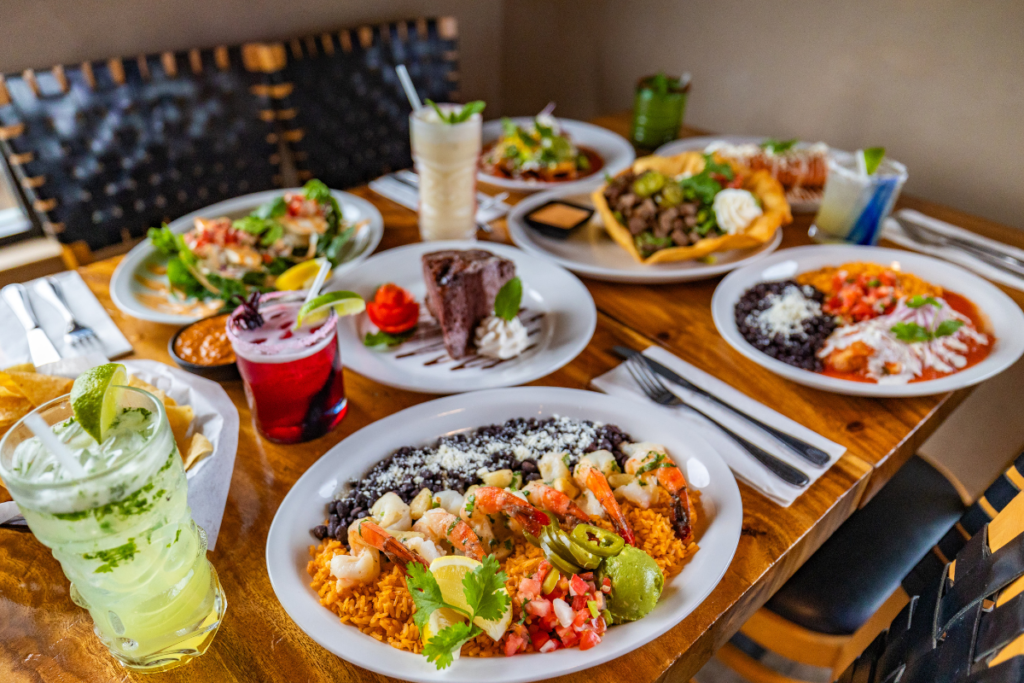Flowing Waters

When Dr. Craig China purchased a vacant lot in Nuuanu Valley in 1999, he was surprised to find he’d also bought a little-known, little-seen remnant of Oahu history, too. The deed to China’s 12,000-square-foot property indicated that he was now responsible for the upkeep of its portion of the Nuuanu auwai, early Hawaiian irrigation canals that once flowed into an extensive network of loi kalo (terraced taro fields) blanketing the lush, residential valley neighboring urban Honolulu. The auwai coursed through his property and down the road, emptying into Nuuanu Stream, the valley’s principal stream.
“I’d wanted something unique, and this water feature was it,” says the 56-year-old geriatrician, as we walk the ‘auwai, now filled with colorful koi and lined with rocks, running across his front yard. “It brings people back to the old days, how ancient waterways can mix with modern development within a harmonious environment. It really defines Nuuanu.”
I had never heard of the Nuuanu auwai prior to moving to the valley a year ago. On walks through the valley’s Dowsett Avenue neighborhood with our dogs, my husband, who grew up in Nuuanu, would point out the small, meandering freshwater streams, which connected at various points. Stretching out his arms for emphasis, he explained that the entirety of the area was once filled with loi kalo. Kalo, in fact, still spontaneously grows in resident yards here, including our own.
Some Nuuanu residents have embraced their property’s auwai, constructing small bridges across them or landscaping the banks of their flowing waters with palms, ferns and native plants. On some of our walks, we’ve even seen kids hunting crayfish in the narrow auwai canals, which also course along some public sidewalks, disappearing beneath driveways and streets before emerging elsewhere.

Nuuanu Valley’s auwai system was constructed centuries ago by hundreds of Hawaiian men, working under the direction of chiefs and area landowners. Connected to inland streams, the auwai diverted water to and across terraced kalo fields that rose like steps on a steep gradient.
“I have seen whole mountains covered with such fields, through which water gradually flowed,” wrote Otto von Kotzebue, a visiting Russian naval officer, in 1821. “Each sluice formed a small cascade which ran … into the next pond, and afforded an extremely picturesque prospect.”
At that time, Nuuanu Valley was one of the island’s most important breadbaskets, providing ulu (breadfruit), uala (sweet potato) and kalo. According to Hawaii writer Thomas K. Lalakea, auwai water rights were regulated by time increments and further based on the number of men individual landowners had tasked to build it. More men, more water.

Additionally, only kalo was allowed to benefit from auwai waters.
Wrote Lalakea, “Control of the auwai and its users was directed by the chief holding the most rights to water usage. He was the luna wai, or water boss, who directed the cleaning and repair of the auwai and rewarded or punished growers with increased or lessened rights to water usage according to their performance in tending the auwai.”
The auwai were, in fact, deemed so important to the production of kalo that any misuse or damage to any part of the system was met with punishment and, sometimes, death.

“If you took too much water or didn’t take care of it, your head went into the headwaters and that was the end of you,” says Shannon Wilson, a bright-eyed, 80-year-old Dowsett resident and president of the Nuuanu Valley Auwai Study Group. The neighborhood volunteer group was formed more than a decade ago to restore and preserve the auwai.
Beginning in the mid-1800s, loi kalo acreage was transitioned to rice paddies and, eventually, into a residential area, now coveted for its unique quietude and century-old historic homes just outside of Honolulu’s urban core. When the Honolulu Board of Water Supply discontinued maintenance of the Nuuanu auwai in the late 1970s, responsibility of upkeep fell to individual landowners.
A few property owners decided they didn’t want the auwai on their property, opting to cement the waterways or allowing them to go unmaintained. Sadly, there’s little anyone, including the concerned citizens of the Nuuanu Valley Auwai Study Group, can do about it.
“People own the land under the auwai,” Wilson says. “And some of them don’t want to take ownership of it.”

Out of the valley’s original 14 auwai, only eight still have flowing water. The study group, which has grown from four members at its founding to about 60 today, tries to raise awareness among area residents about the importance of preserving this unique part of the valley’s history. A few, including China, regularly remove debris and other obstructions from the neighborhood ‘auwai. Twice a month, he cleans the ‘auwai above his property to ensure its waters keep flowing. As some residents, like him, have turned portions of their ‘auwai into enclosed fish ponds, China checks water quality, too.
“People think that when it rains here, the auwai floods, but that’s not the case,” says China, who serves as the luna wai of the auwai system that flows through his yard. “In fact, it’s just the opposite.”
Heavy rains and high winds often cause debris such as branches and leaves to clog the ‘auwai and slow their flow. That’s when China, his neighbor and, sometimes, his teenage son, don safety vests and spring into action.

China and I sit on his front porch while he discusses improvements he still hopes to make to his already picturesque yard, which boasts koi ponds, a bamboo grove, a golden poinciana tree, longan and jabong (pomelo) trees and a lychee tree that provides shade but no fruit. He’s considering building a bridge and putting out a table and chairs.
“I really want to make it more of a place to decompress and reflect,” he says.
His goal for the auwai is the same as Wilson’s and, really, every Nuuanu resident who cherishes these unique remnants of the valley’s agricultural past.
“I want people to have an awareness of the cultural legacy of the auwai and take responsibility for it,” says China. “And I just want to keep the water running. Because, one day, that may stop. Keeping the water running. That really is the dream.”


